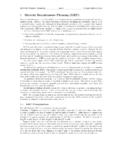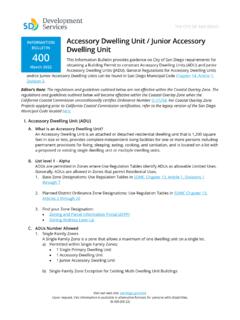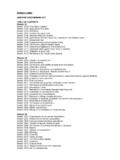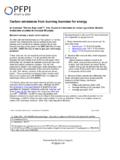Transcription of Unit 2: Planning to Meet the Needs of Learners in ...
1 unit 2: Planning to Meet the Needs of Learners in Education and Training unit reference number: A/505/1189 Level: 4 Credit value: 3 Guided learning hours: 15 unit aim The aim of this unit is to enable the learner to agree individual learning goals with their students, to plan inclusive teaching and learning in accordance with internal processes and external requirements, and to evaluate their own practice in Planning teaching and learning. It covers what expectations are in relation to the minimum core in Planning inclusive teaching and learning.
2 In August 2003 FENTO introduced the minimum core of language, literacy and numeracy for inclusion in all post-16 teacher education programmes. Since September 2000 it has been expected that initial teacher education programmes should equip all trainee teachers to develop inclusive approaches to addressing the language, literacy and numeracy Needs of their Learners . This unit addresses issues underpinning the Planning of learning and teaching from the first point of contact with students, through initial and diagnostic testing. Understanding the role of initial and diagnostic assessment will enable Learners to actively negotiate and record individual goals.
3 This, in turn, will enable their students to take increased responsibility for the learning process. In all the units in this qualification there is a need to evaluate practice and involve Learners in the process in order to develop the best practice in teaching and learning and to create opportunities to incorporate minimum core requirements. This unit addresses the need to identify ways in which learning and teaching may be improved to meet individual learner Needs . This means that emphasis must be placed on opportunities for Learners to evaluate their own Planning and preparation of sessions that form part of their teaching practice.
4 Essential requirements There are no special requirements for this unit , but it should be approached with a consideration of the links between this unit and the others in the Certificate. In particular, this Planning unit must be developed through the delivering unit in order to make the most effective use of evidence such as scheme of work and session plans. 34 Pearson BTEC Level 4 Certificate in Education and Training Specification Issue 2 August 2017 Pearson Education Limited 2017 Learning outcomes, assessment criteria and unit amplification To pass this unit , the learner Needs to demonstrate that they can meet all the learning outcomes for the unit .
5 The assessment criteria determine the standard required to achieve the unit . Learning outcomes Assessment criteria unit amplification Delivery guidance 1 Be able to use initial and diagnostic assessment to agree individual learning goals with Learners Analyse the role and use of initial and diagnostic assessment in agreeing individual learning goals Role, information for course tutor, current levels knowledge and understanding, existing skills, achievements, motivation, background. Learning goals, requirements of learning programme, individual or group contracts, goals identified through learning or training Needs analysis, long- or short-term target setting, action plans, ILP.
6 Learner-led discussion leading to context-based research task (individual or pairs) Use and analysis of individual diagnostic assessment activities, LNA (Learning Needs Analysis) Organisation policies and procedures for initial and diagnostic assessment Examples of methods used with own Learners and recording used Personal learning log. Use methods of initial and diagnostic assessment to negotiate and agree individual learning goals with Learners Methods, negotiation, self- assessment, tutorial, discussion, recognising learning or skills gaps, agree support Needs , need for referral as appropriate, liaise on behalf of learner.
7 Record Learners individual learning goals Recording, Individual Learning Plans (ILP), action plans, paper- based or IT-based, organisation procedures for recording information, learner ownership, sharing others 35 Pearson BTEC Level 4 Certificate in Education and Training Specification Issue 2 August 2017 Pearson Education Limited 2017 Learning outcomes Assessment criteria unit amplification Delivery guidance 2 Be able to plan inclusive teaching and learning in accordance with internal and external requirements Devise a scheme of work in accordance with internal and external requirements Curriculum requirements.
8 Interpretation of awarding body outcomes, requirements of professional/vocational standards, knowledge content, skills opportunities, sequencing of content, required level. Assessment requirements, methods and schedule, evidence requirements, moderation and standardisation. Learner requirements, learning preferences, individual and group work, equality of access, developing on and reinforcing learning, opportunities for study skills. Organisational requirements, standardisation, internal quality assurance, inspection criteria Review examples of scheme of work exemplars Individual research into own curriculum or unit guidance Practical activity pairs or small groups Learner-led discussions Personal learning log Design teaching and learning plans that meet the aims and individual Needs of all Learners and curriculum requirements Learning plans, aims and objectives, subject knowledge and skills content, timing, sequencing, range of approaches.
9 Linked assessment, opportunities for minimum core. Learner requirements, variety of learning and teaching activities, opportunities to demonstrate and practice skills, planned reflection, opportunities for feedback. Learning preference questionnaires, Honey and Mumford Workshops for session Planning skills Case studies created or based on individual practice Tutor- led or learner-led discussions Personal learning log 36 Pearson BTEC Level 4 Certificate in Education and Training Specification Issue 2 August 2017 Pearson Education Limited 2017 Learning outcomes Assessment criteria unit amplification Delivery guidance Explain how own Planning meets the individual Needs of Learners Learner Needs , recognition of differences.
10 Varied aspects of Kolb s Learning Cycle (activity, reflection, research, Planning ), Planning around Bloom s types of learning (knowledge, attitude, skill), providing flexible approaches, resources-based learning, encouraging independent learning, learner centred, opportunities to check and correct learning. Research and presentations Small groupwork activity Tutor led or learner-led discussions. Personal learning log Explain ways in which teaching and learning plans can be adapted to meet the individual Needs of Learners Adapting plans, negotiating to meet individual Needs , alternative activities, individualise learning plans, extension activities, blended learning to increase flexibility, presentations, focus on group or collaborative activities, peer teaching.










